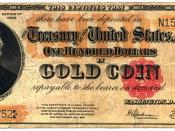The gold standard is the idea that gold, rather than paper money, holds a specific value and goods and services are to be priced according to that value. The value is based on the weight and fineness of the gold bullion. Just after the Great Depression, one of major ideas to get the economy booming again was that gold and silver could be a great source of wealth for the United States. Early economists did not believe in anything except payment for any goods in gold. Major advantages said that gold was the only type of wealth to actually be held on to and for the most part it would not lose its value. (We know that this wasn't true!) Other ideas included that gold is the only way for a nation to gain power and riches. Economists figured that the only way to store up gold was to have a surplus of exports to countries and payments were to be in gold.
The more they exported the more they country would get back in gold. There was also belief that increases in the amount of gold circulated would reduce interest rates and promote business.
The gold standard trend caught on very quickly and soon the United States became accustomed to it. The economic devastation after World War I saw most of the developed nations suspend their gold standards (to later return to it) and all suffered from varying degrees of inflation. Devaluation is done in to reverse inflation, a step crucial to returning to the gold standard. There were a number of devaluation's in the 1920's to go back to the gold standard, as much the world did after the war. These devaluation's were used as "runs" on currencies that boosted employment and an increased the business cycle.


